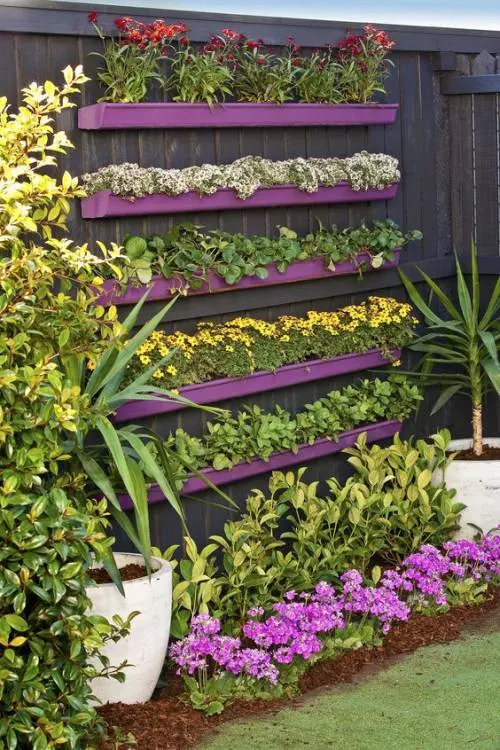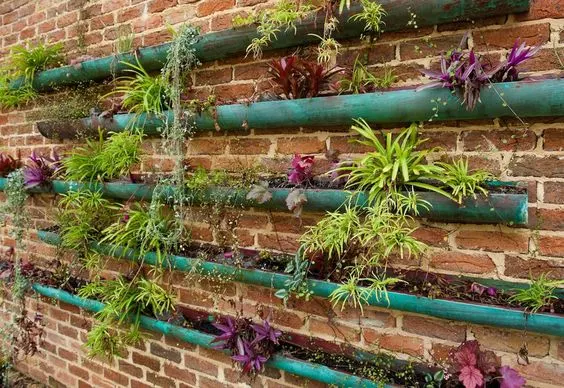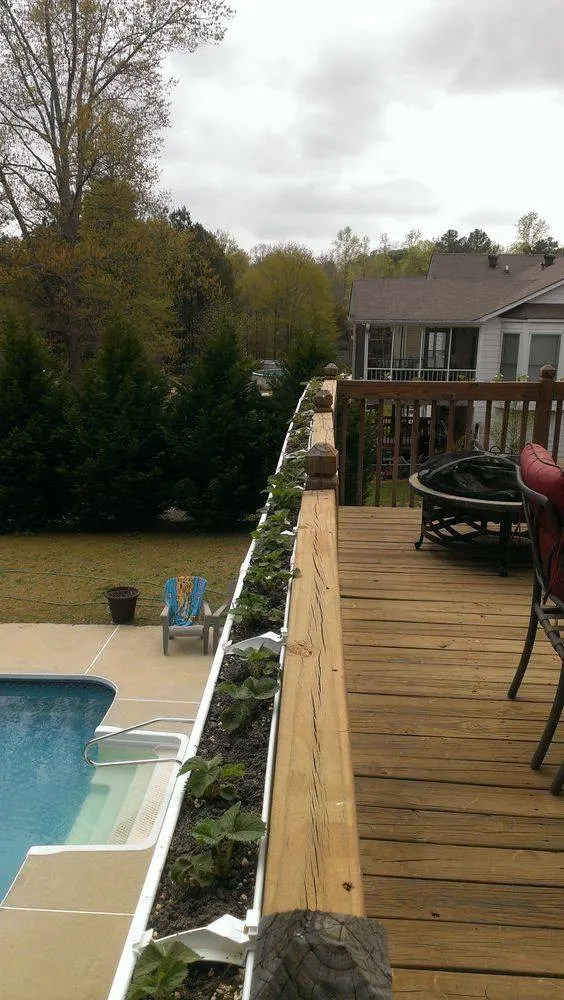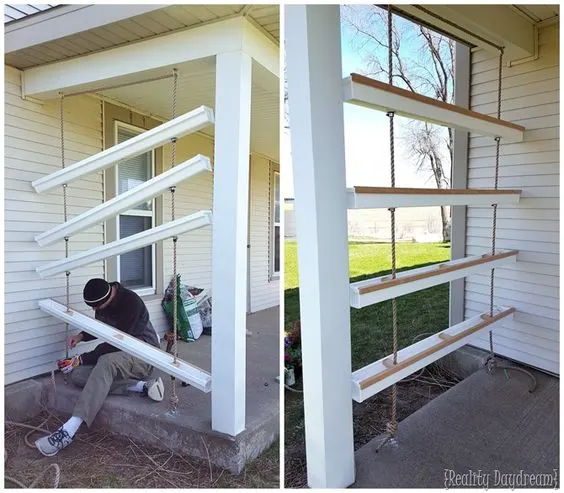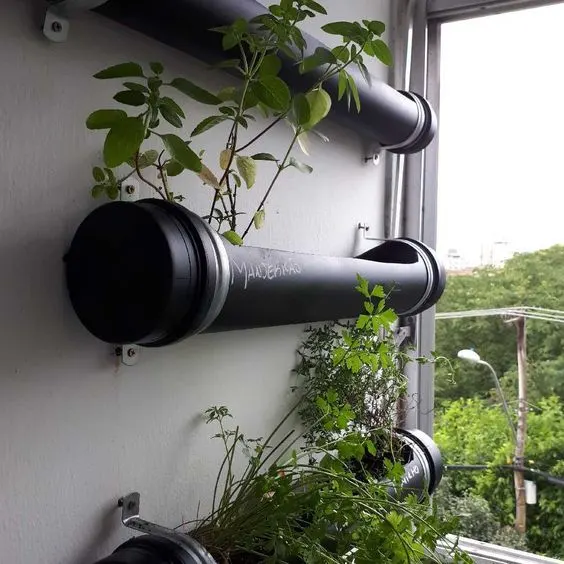Rain gutter gardening has been in the public eye for quite some time.
If your trivial lawn doesn’t allow you to act all high and mighty, or you don’t have a backyard where you can grow countless of your favorite fruits, vegetables, and flowers, rain gutter gardening might be your silver bullet!
Yes, building yourself an exquisite rain gutter garden (which, by the way, we will discuss in today’s article) will allow you not only to have an endless supply of homegrown edibles but also to embellish your indoor and outdoor spaces with nature’s magnificent allure.
From old rain gutter gardening ideas to the plants you can grow in your gutters, we are going to pass the time debating about all the aspects of rain gutter gardening.
So, if you are ready to embark on this amazing journey, stay with us till the end.
And buckle up, ‘cause … here we go!
- Rain Gutter Gardening | An Overview!
- Things You Need to Gear Up!
- How to Make a Rain Gutter Garden? | A Step-by-Step Approach!
- Step 1: Choose a Location
- Step 2: Measuring and Planning
- Step 3: Chop Chop!
- Step 4: Attach the End Caps
- Step 5: Drilling
- Step 6: Mount Gutter Hangers
- Step 7: Hang the Gutters
- Step 8: Add Potting Mix
- Step 9: Start Planting
- Step 10: Hydrating your Green Buddies
- Step 11: Pest Protection
- Step 12: Harvest Happiness!
- 7 Rain Gutter Garden Ideas!
- Plants You Can Grow in Your Gutter Garden
- Conclusion!

Rain Gutter Gardening | An Overview!
Rain gutter gardens have brought an innovative touch to the gardening world.
With their increasing popularity among homeowners, rain gutter gardens have become an excellent alternative to container gardening.
Above all, rain gutter gardens allow you to grow a stunning display of your own food, favorite veggies, herbs, and flowers, even if you don’t have a big yard or a garden.
But with this space-efficient technique of growing greeneries, you’ll also need to care for your gutter gardening system properly.
Gutter Garden Care!
Proper maintenance is the key to a thriving gutter garden because it ensures the longevity and functionality of a gutter garden.
A well-maintained rain gutter garden is essential for many reasons.
Here are some key benefits of a properly maintained gutter garden system.
It prevents pests and water damage.
It protects the structural integrity of the system.
It maintains the aesthetic appeal of the garden.
Are you looking for some first-rate care techniques for a thriving rain gutter garden?
Well, your time of seeking is over!
Let me tell you some excellent care techniques for a thriving gutter garden.
Watering: The most crucial necessity to maintain a thriving gutter garden is watering. As we know, rain gutters are shallow containers, so watering them twice a day is essential to prevent the plants from desiccating when the climate is hot.
Fertilization: It is also essential to fertilize the plants you are growing in rain gutters to ensure their maximum health. It is crucial to consider that the nutrients will drain quickly from the soil, so gutter gardens must be fertilized frequently, except for bog and succulent gardens.
Soil replacing: The soil will become a solid part of the roots by the end of the season, so it’s best to replace it with fresh soil annually to keep the plants happy and cherished.
Cleaning: Cleaning is an integral part of maintaining a rain gutter gardening system. Cleaning your rain gutters regularly is essential as it prevents clogs and mold growth. Remove leaves and debris by hand or with a scoop to clean the gutters. Then, flush the gutters with a hose to ensure proper water flow to maintain plant health.
Read more to learn about professional rain gutter cleaning services here.
Things You Need to Gear Up!
Here are some essential equipment and materials for rain gutter gardening.
Rain Gutters (vinyl or metal)
Tools (trowel, pruners, and gardening gloves)
Measuring Tape
End Caps
Screws and Anchors (if needed)
Drill (to drill holes for proper drainage)
Hooks or Hangers
Mounting Brackets
Level (for leveling)
Ladder (if it is high up)
Potting Mixture (organic potting soil)
Plants or Seeds
Fertilizer
Watering System (hose or watering can)
Choose your rain gutter garden gear wisely! Think about what your plants love and where your garden sits.
Plan ahead and give your green buddies the best.
How to Make a Rain Gutter Garden? | A Step-by-Step Approach!
Here’s a step-by-step approach to making a rain gutter garden.
Step 1: Choose a Location
Find a sunny spot for a thriving rain gutter garden.
It should receive adequate sunlight for the plants you plan to grow in your rain gutters. South-facing walls or fences are considered a good choice for your green buddies.
Step 2: Measuring and Planning
Measure up the length of the area where you want to grow your rain gutter garden to see how much space you’ve got.
This will help you determine the number and length of gutters you need.
Step 3: Chop Chop!
Time to play lumberjack!
Grab a saw and cut the rain gutters to your desired length based on your measurements. Remember, your cuts should be straight and clean.
Step 4: Attach the End Caps
Now, it’s time to cap your gutters off.
Attach end caps at both ends of the rain gutter. Use a nifty, suitable adhesive to secure them in place. It will prevent the soil and water from spilling out of the rain gutter.
Step 5: Drilling
Drill small holes (1/2-inch diameter holes every six inches) in the bottom of your rain gutters for drainage.
It will help the water to escape the rain gutter and prevent waterlogging problems.
Step 6: Mount Gutter Hangers
Install the hangers on the wall or fence where you want to hang your rain gutters. Use a level to see if they are straight and perfectly leveled like a pro.
Step 7: Hang the Gutters
It’s time to hang your rain gutters on the installed hangers. Hook the gutters on the hangers securely. Ensure they have a slight slope so the water can easily drain out.
Step 8: Add Potting Mix
Now, fill your rain gutters with top-notch potting mix. It is essential to leave a small gap at the top to prevent the soil from spilling out when you water it.
Step 9: Start Planting
Plant your chosen seeds or plants you want to grow in your rain gutter garden, but be mindful of the depth and spacing, following the references for the specific plants you’re growing.
Step 10: Hydrating your Green Buddies
Water your rain gutter garden regularly!
Use a watering can or a gentle hose spray to moisten the soil but ensure they don’t waterlog.
Don’t forget to give your green buddies some plant food if they look hungry; fertilize them following the recommendations for the plant types you’re growing.
Step 11: Pest Protection
Watch out for pests and diseases and take appropriate measures to protect your plants. If your plants get sick, be their doctor and nurse them back to health.
Step 12: Harvest Happiness!
Enjoy the fruits (or veggies) of your labor as your vegetable garden grows! Harvest when the time is right and taste the deliciousness.
Now, kick back, relax, and soak in the green goodness of your incredible rain gutter garden!
7 Rain Gutter Garden Ideas!
Are you looking to make the most of your limited gardening space?
Let’s dive into seven innovative gutter garden ideas that will inspire you to transform your space into a flourishing oasis and make your garden bloom like never before.
1. Classic Rain Gutter Garden
A classic rain gutter garden is a space-saving gardening technique.
It is a traditional rain gutter garden commonly known as a vertical wall gutter garden, mounted along a fence or a wall.
Classic rain gutter garden is ideal for outdoor spaces like gardens and yards and is an excellent way to maximize space for gardening if you are living in an urban area or a small living environment. It also keeps your plants elevated, which helps to keep ground-dwelling pests away.
It is suitable for growing a variety of herbs, small plants, and flowers.
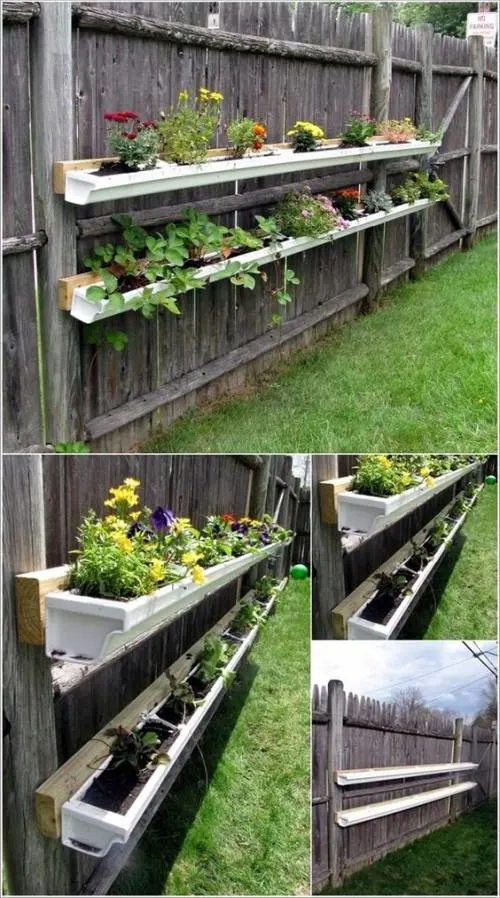
2. Freestanding Gutter Garden
Freestanding gutter gardens are perfect for areas without available wall or fence space. You just have to construct a stand-alone frame to hold the gutter sections.
You know what’s cool about a freestanding gutter garden?
It offers flexibility in garden arrangement and placements. You can place it indoors and outdoors. You are good to go as long as there is sufficient sunlight inside your house for the plants you intend to grow in your rain gutters.
You can also fit it with a set of wheels to quickly move your gutter garden indoors when the weather is cold.
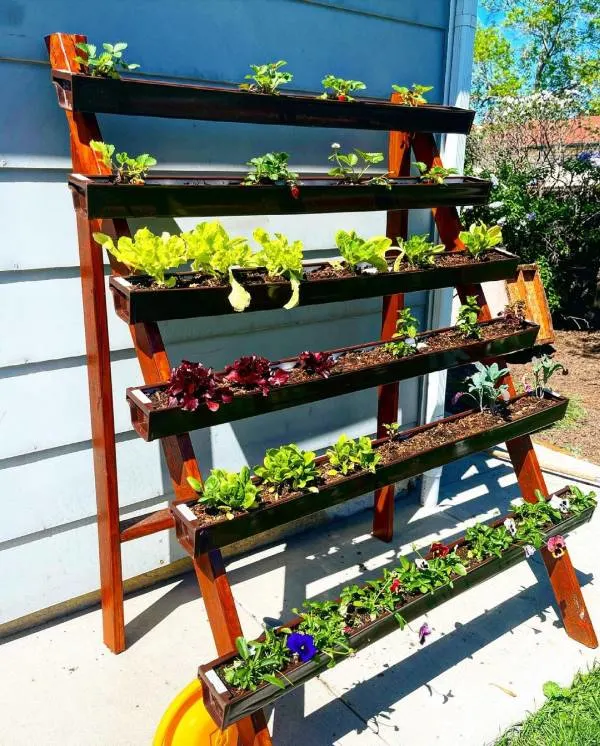
3. Hanging Gutter Garden
A hanging rain gutter planter garden is a unique decor idea to add the “WOW!” to your outdoor space.
Rain gutters become hanging containers for beautiful purslane plants or whichever plants you desire. It is a great idea to grow your gutter garden if you have small spaces like patios and balconies.
You can hang your gutter sections both horizontally and vertically.
Utilize hooks or brackets to suspend the hanging gutters from a structure and place them in a bright spot to ensure proper sunlight to your plants.
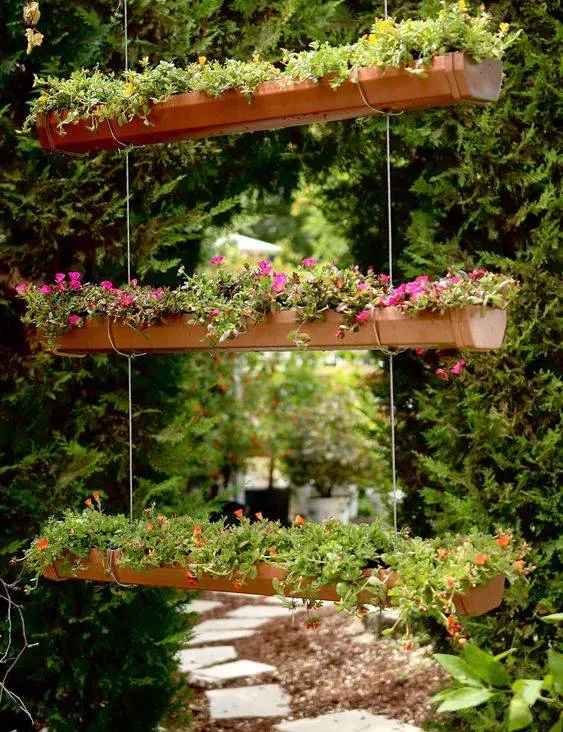
4. Framed Gutter Garden
Rain gutter gardens can be visually appealing when you combine the rain gutters with decorative and aesthetic frames.
Framed gutter gardens allow you to maximize vertical space to grow more plants in a limited area and are suitable for both indoor and outdoor settings.
This gutter garden design provides more space to grow herbs, strawberries, lettuce, spinach, and other plants with shallow roots.
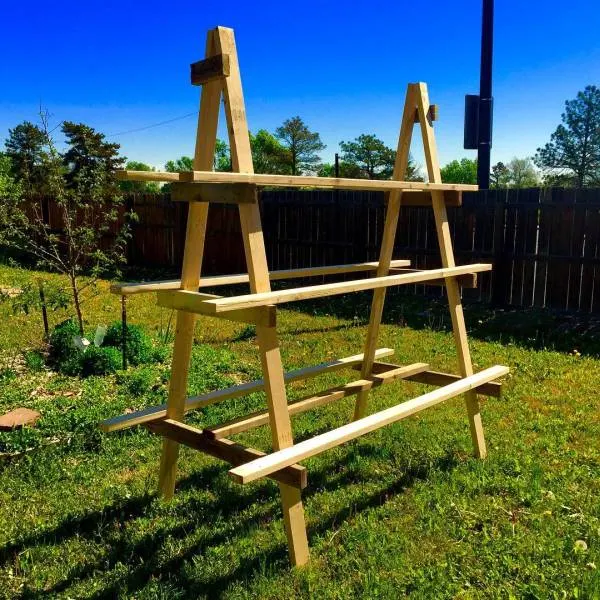
5. Deck Gutter Garden
A deck gutter garden is designed to fit on deck railings or balusters, maximizing the vertical space and adding greenery to your deck.
It’s like mother nature decided to decorate your space with her finest artistry.
You step out onto your cozy deck, sipping on your morning coffee, and your eyes are immediately drawn to a vibrant burst of greenery hanging from the edges of your back deck railing. That’s right, it’s your very own deck gutter garden!
It is excellent for growing herbs or small flowers for easy access.
So, whether you have a green thumb or you’re a gardening newbie, a deck gutter garden is the secret ingredient to turning your outdoor space into an irresistible oasis of charm and beauty.
6. Patio Gutter Garden Ideas
A patio gutter garden is a vertical gardening system that utilizes gutters as plant containers to grow various plants, typically herbs, vegetables, or small flowers.
This gardening method is particularly suitable for small outdoor spaces like patios, flat outdoor surfaces, balconies, or even windowsills where traditional gardening beds or pots may be limited in space, enhancing the ambiance of your outdoor living space.
You can arrange it in various configurations to suit your patio’s layout.
7. Indoor Gutter Garden Ideas
Create a beautiful indoor garden that combines both elegance and practicality. Fill it with vibrant green plants that not only look stunning but also bring the benefits of nature into your space.
Adapting gutter gardens for indoor use with suitable lighting is a brilliant way to bring floral beauty inside your home.
You can also consider using grow lights for optimal plant growth.
This innovative adaption is perfect for growing various plants, from sweet-smelling herbs to hardy succulents and charming decorative flowers.
Plants You Can Grow in Your Gutter Garden
Are you looking for plants to grow in rain gutter gardens?
Well, here are a variety of plants you can grow in your gutter garden.
1. Vegetables
Rain gutter gardens work well for growing plants that have shallow roots. You can consider growing lettuce, spinach, carrots, beets, green onions, radishes, etc.
Growing vegetables in rain gutters is a creative and space-saving gardening technique.
At the same time, not all vegetables are suitable for this method. For example, heavy plants like tomatoes and broccoli are unsuitable for gutter gardening.
2. Herbs
Growing herbs in rain gutters is a creative way to cultivate fresh herbs. It’s advantageous if you have limited garden space or want to keep your herbs easily accessible.
You can grow herbs like mint, chives, thyme, oregano, basil, sage, lavender, and cilantro, as they can thrive in gutter gardens with good drainage.
3. Fruits
Although it’s not a typical method for fruit cultivation, you can grow certain fruits in rain gutters.
When setting up a gutter garden for fruits, it’s essential to choose the right type of gutter material and provide adequate support for the plants.
You can grow fruits in rain gutters like strawberries and cherry tomatoes.
Some trailing blackberry varieties, such as the ‘Black Cascade’ or ‘Baby Cakes,’ can also be grown in rain gutters.
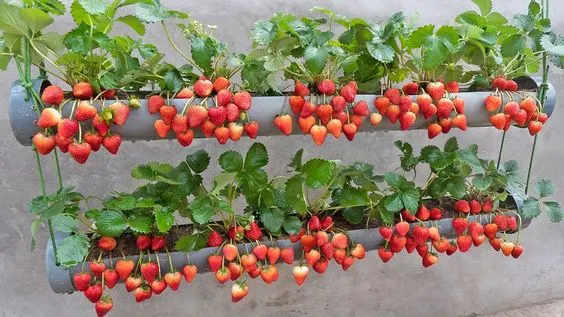
4. Flowers
Flowers in gutter gardens bring a pop of vibrant color in the most unexpected spots!
Who knew that those practical gutters could turn into charming floral displays? Their delicate petals and varied shapes turn these gutters into living art, adding beauty and serenity to urban areas.
Attractive flower varieties like marigolds, creeping jenny, violas, verbena, poppies, alyssum, and nasturtium, when grown in rain gutters, enhance the attractiveness of your gutter garden.
5. Succulents
Small succulent species are ideal for gutter gardens because they thrive in shallow soil and require minimal water. Their shallow roots fit well in gutters’ limited space, and their water-storing leaves make them drought-resistant.
They prefer well-drained conditions, preventing waterlogging.
Compact and visually appealing, these succulents are a low-maintenance choice for gutter gardening, adding beauty to your garden without much effort.
Succulent species such as Sedums, Echeveria, Crassula, Portulacaria afra (Elephant Bush), and Sempervivum are suitable to grow in rain gutters.
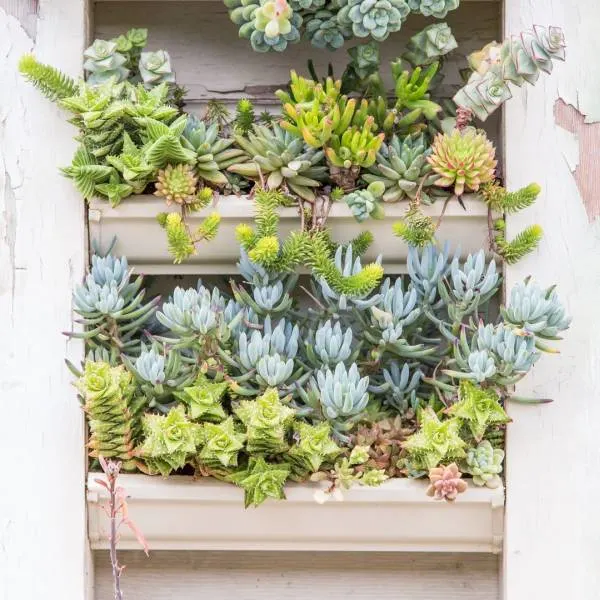
Conclusion!
In conclusion, creating an exquisite rain gutter garden is a delightful and practical way to cultivate herbs, flowers, or even small vegetables in limited space.
Remember that proper drainage is essential in gutter gardening, as excess water can be problematic. Drill drainage holes in your gutters and use a suitable growing medium to prevent soggy roots. Choose a location that receives adequate sunlight for the specific vegetables you plan to grow, as sunlight requirements can vary.
Additionally, consider providing some protection from extreme weather conditions, such as excessive rain or strong winds, which can affect the health of your gutter garden.
That’s all for today’s article!
I hope you like it.
If you do, don’t forget to like, comment down below, and share it with your friends.
Happy gardening!

